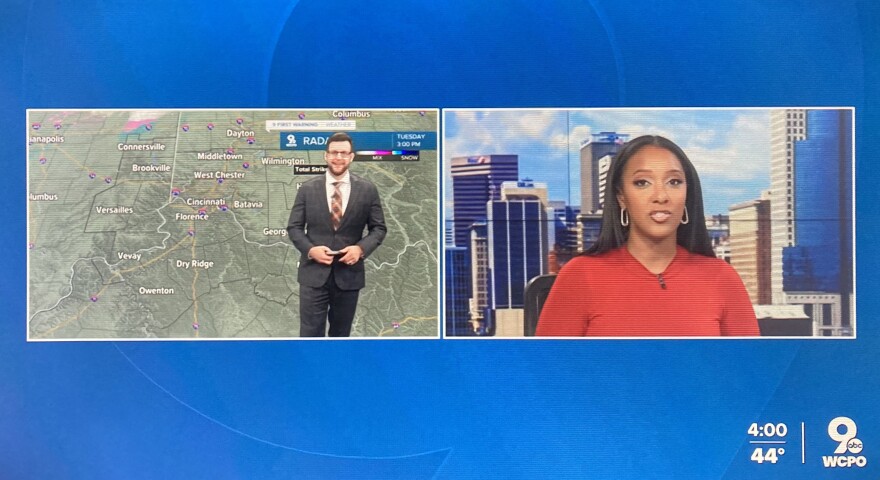Unlike the personality-driven 4 p.m. newscasts with Sheree Paolello on WLWT-TV and Trisha Macke on WXIX-TV, there's no chitchat with reporters by WCPO-TV anchor Jasmine Styles at 4 p.m.
In fact, Styles doesn't navigate viewers through the one-hour newscast introducing the stories — the traditional anchor role on TV for decades on Channel 9 — or the competition on Channels 5, 12 and 19.
The 4 p.m. WCPO-TV newscast, which uses E.W. Scripps' "Scrippscast" computer technology, delivers local and national stories by reporters who introduce themselves and their topics after graphics reading "TOP STORIES," "MAKING NEWS," "YOUR HEALTH," "SUSTAINABLE FUTURE," "ECONOMY WATCH" or the 9 ABC WCPO logo.

It's a look into the future of TV news on WCPO-TV, which has led the market in innovations. Last December, WCPO-TV became the first Cincinnati station to pull main anchors off the 11 p.m. news so Tanya O'Rourke and Craig McKee could report more stories during daylight hours.
WCPO-TV has been using the Scrippscast computer-assembled format at 4 p.m. since June, and soon will apply it to the late Saturday night news following ABC's college football telecasts. Channel 9 also uses Scrippscast for its FC Weekly show. Scripps' stations in Michigan, Florida and other areas also use the anchor-diminished Scrippscast format
"Many Scripps stations are using the 4 p.m. format you see on WCPO 9. I am not sure how many other Scripps stations are using the Scrippscast software, but I believe many are using it in some capacity because it is a valuable tool," says Jeff Brogan, WCPO-TV vice president and general manager.

On Tuesday, the only time Styles interacted with a live person was introducing meteorologist Brandon Spinner on a split screen in the first minute. Reporters Madeline Ottilie and Anna Azallion opened their taped reports by introducing themselves from Middletown and Northside, respectively.
The hour was split nearly equally between local stories (16) and national reports (15). But only five of the 15 stories identified the reporter as being from Scripps News; the other 10 were by unidentified women anchors or anonymous off-camera voices. The 4 p.m. newscasts I've watched recently always included a taped "Don't Waste Your Money" segment by consumer reporter John Matarese, and a taped segment with Good Morning Tri-State anchors Adrian Whitsett and Kristen Skorvira.

"Most newscasts across the country are a mix of stories on tape and stories read from an anchor desk," Brogan explains. "In some of our newscasts, like the 4 p.m., we lean more heavily into stories put together by journalists outside the studio, including live reports from important events. In all our newscasts, we offer live weather and aggressive coverage of breaking news or any other changing situation that matters to our viewers. Some of our stories and newscasts don't look as traditional as others, but they are all created by experienced journalists."
The Scrippscast format — self-contained short videos on a specific subject — also should appeal to younger viewers who consume lots of videos on their phones, tablets or other mobile devices, and don't generally watch local TV newscasts.
Brogan also says that the smaller role for anchors is not a cost-cutting measure.

"The change in format and technology gives our anchors more opportunities to work on stories," he says. The station works "constantly to make our newscasts and stories better. Our goal with the most recent changes is to have more journalists out in our community, and to give our anchors more opportunity to not just read the news, but also report it."
Scripps, he says, has "spent a lot of time talking to news consumers across the country and here in Cincinnati. They clearly want to see anchors who don't just sit behind a desk. They want to get their news from working journalists, who report in the community about stories that matter to them.
"We know that the best way to serve and connect with our audience is to get out of the studio and into neighborhoods. To do this, we continue to look at different newscast formats and utilize technology like Scrippscast. These tools give our anchors more time to produce quality stories that matter to our viewers.
"Within the last year, our anchors have been out reporting a lot more, allowing us to better understand what's on the minds of people in and around Cincinnati. Our goal is to get out all over the Tri-State area, find stories that matter to our audience, and tell those stories well. Our anchors are central to that plan. We are also making a significant investment in hiring more reporters.
"To further support this goal, we hope to use our valuable Scrippscast software for some other newscasts," Brogan says.
Stay tuned.



